Introduction
This article advises how I have replaced a Mira Shower thermal switch in a MIRA Sport 9kW Thermostatic Shower on several occasions.
Originally I installed a MIRA Sport 9kW Thermostatic Shower as part of a new bathroom and had it tested and certified by a qualified electrician on 1st May 2007. I was very pleased with it and it worked well for three years until June 2010 when it developed a fault.
I found that in the middle of taking a shower the water would go cold for a few seconds and then get warm again. On the first few occasions I wondered if cold water being drawn off by other taps and appliances was lowering the water pressure to the shower and so causing it to operate incorrectly (although the low pressure light was not illuminating). As the days went by the problem got worse and my wife ended up washing shampoo off with cold water. I knew then that I would be in bad books until it was fixed.
I had to determine if this fault could be fixed or if I would have to replace the entire shower unit. For this I needed to take a look inside the shower unit.
Taking A Look Inside

WARNING: There is a danger of electric shock which can cause DEATH when working on an electric shower if it is not fully isolated from the mains supply.
DISCLAIMER: All people working on electric showers do so at there own risk. I take no responsibility for other people’s actions. If you are not qualified to work on electric showers then invite a person who is qualified to do the work.
REMEMBER: People who work on showers are responsible for the safety of those who use them.
“Beware of counterfeit copies of The IET Wiring Regulations.” — HC

BATHROOMS IN THE UK: These have specific EQUIPOTENTIAL EARTH BONDING requirements to ensure that a dangerous potential cannot exist between any metal fixtures, e.g. pipes, radiators, taps, light fittings, showers, etc. Many old bathrooms fall short in this area and must be brought up to date when an electric shower is fitted. See BS7671 and the Institute of Engineering and Technology (IET) Wiring Regulations. BEWARE of counterfeit copies of The IET Wiring Regulations1.
Before looking inside I:
- turned off the shower using the Isolating Switch in a cupboard outside the bathroom and observed that the light behind the shower button went off at the same time.
- operated the Test button on the Residual Current Device (RCD), also in a cupboard outside the bathroom. In most cases the RCD can be found inside the consumer unit adjacent to the Miniature Circuit Breakers (MCB’s). NOTE: pressing the TEST button of an RCD in a consumer unit may disconnect other circuits in the house, e.g. circuits that carry power to a freezer (which you wouldn’t want to switch off) or a computer (which you would want to shut down first.)
- switched the 40Amp MCB, devoted to the shower, in the consumer unit to the OFF (down) position. This involves pushing the lever down from its normal working position.
Since the wiring to this shower was familiar to me I was happy with these isolating procedures. Had it been an unknown situation I would have tested the voltage at the shower cable terminals with a known working meter to see if there was any voltage between:
- the LIVE terminal and the NEUTRAL terminal.
- the LIVE terminal and the EARTH terminal.
- the NEUTRAL terminal and the EARTH terminal.
- each terminal and some alternative earth, e.g. the taps or pipework.
SAFETY NOTE: If a switch or MCB is labelled ‘SHOWER’ it doesn’t prove it is the shower switch or MCB. So it is important to be vigilant and check it does isolate the SHOWER.
Tools For Replacing A Mira Shower Thermal Switch
Three Posidriv PZ.2 screws hold the case front cover on and all the electrical connections and fixing screw for the thermal switch are made with TORX T-15 screws. So the tools needed are a HEX driver with a PZ.2 bit and a T-15 bit as shown below.
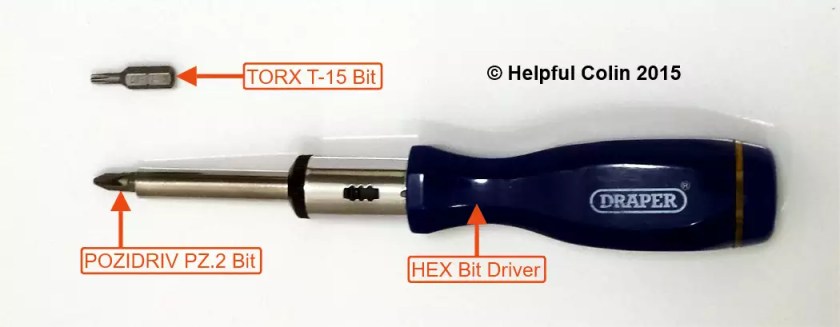
Removing The Front Cover
“First I closed the plug hole in the bath before removing any screws.” — HC
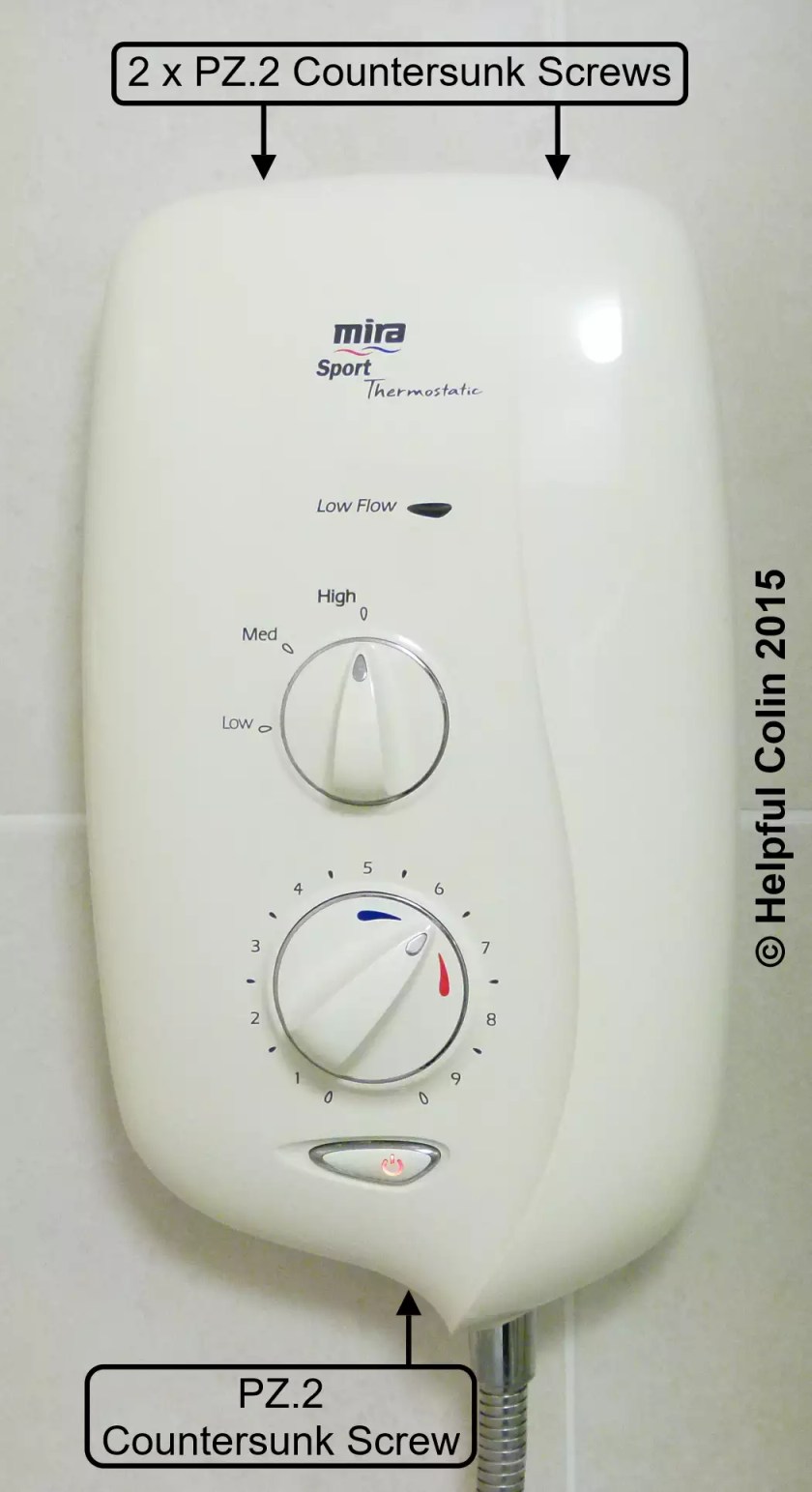
An electric shower has to be installed with the cover removed so that the water pipe can be connected and the electrical connections made. So I was familiar with the layout of the components already having previously mounted the shower on the wall some years before.
The front cover has the Power Setting Switch knob, the Temperature Setting Control knob and the ON/OFF button mounted on it. These are all plastic pieces which engage with the actual control mechanisms on the inside.
Three PZ.2 screws hold the cover in place. They are not visible to an observer looking straight at the front of the shower. The axis of the screws is vertical. Two enter the main case, which is bolted to the wall and has all the working components fixed to it, from the top. They pass down through lugs on the inside of the front cover and on into more of the main case plastic.
Similarly the third screw passes up through a hole in the case immediately to the left of the outlet hose and passes through a lug on the front cover before entering more of the main case plastic.
After removing the cover I carefully placed it in the wash basin nearby without moving the control knobs. I have found it to be a slippery customer so the wash basin’s shape held it well.
“Avoid moving the control knobs and the Front Cover will easily fit in place.” – HC
Looking For The Problem
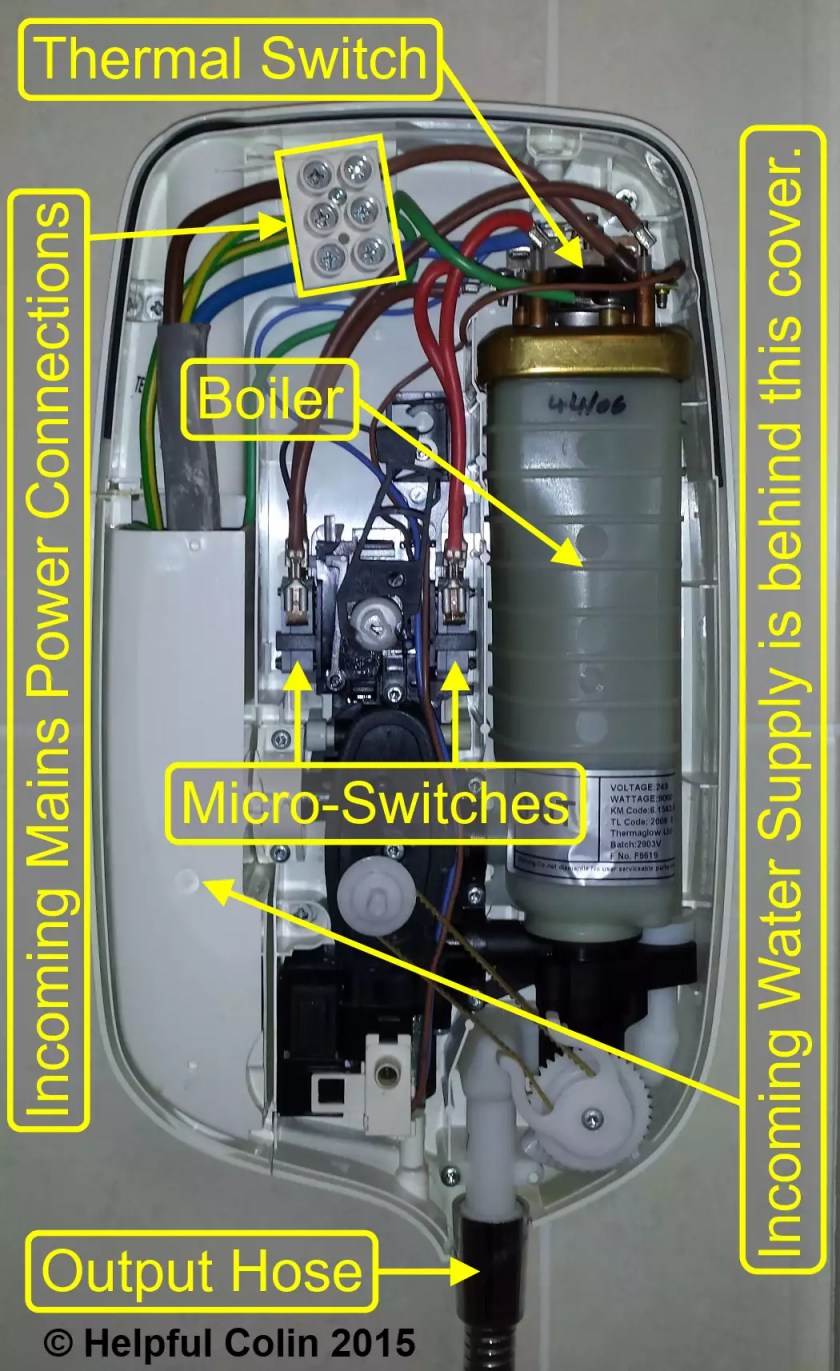
Once I removed the cover from the shower case I examined the shower but couldn’t find any broken plastic parts. There are many moving parts, e.g. levers and gears associated with the various controls, any of which could have broken and prevented the shower from functioning correctly.
However I did find two components which could deteriorate over time and might be cheap to replace. They were the micro-switches which turn the power ON/OFF and the Mira Shower thermal switch which protects the Heater Tank from overheating.
A Corroded Mira Shower Thermal Switch

After removing the Mira Shower thermal switch it became clear to me that it needed to be replaced regardless of whether it was the cause of the immediate problem. It appeared to have become wet with condensation and the bimetallic disc, which bends as it gets hot, had corroded. It comes into contact with the top of the Heater Tank which is made of copper and so electrolytic corrosion occurs when moisture gets between the two different metals. Also electrolytic corrosion occurs between the solder and the copper where the heating elements protrude. and are soldered in place.

Obtaining A New Mira Shower Thermal Switch
I set about locating a supplier of Mira Shower parts and found the Shower Doctor who could supply the Mira Shower Thermal Switch 416.41. From the Shower Doctor’s current web site I was able to determine that there have been several models of Mira Sport showers and my model is post-2006 & ante-2011.
NOTE: At the time of writing the Mira Shower Thermal Switch 416.41 costs £13.94. Back in October 2010 I realised there was an ongoing problem requiring me to obtain several Mira Shower thermal switches so I bought four at £7.32 each.

UPDATE: As of 06/03/2022 Mira Shower Thermal Switch 416.41 is not available from the shower doctor but is available from alternative sources which you can find by searching for it.
Removing The Old Mira Shower Thermal Switch
NOTE: Before disconnecting any wires I made a record of which wires were fixed to the three connections involved, i.e. the two connections for wires to the switch and the one connection for the earth wire. Initially I made a drawing and described the wires by colour and thickness. Today it would be easy for most people to take a digital picture (photograph).
I found the thick brown and red wires fixed to the tag on the left would not stretch over to the tag on the right so they couldn’t get mixed up. The thick brown wire, going to the tag on the right, was the only thick wire that reached that far. It wasn’t difficult to remember that the thin brown wire went to the same tag as the thick brown wire.
NOTE: My shower model has not got an overheating neon light. It appears that some models do have one. The Shower Doctor doesn’t distinguish between the two models as far as I can see. I have seen a Shower Doctor picture with an extra thin black wire connecting to the tag on the left and on the right. I presume these go to the overheating neon light such that when the Mira Shower thermal switch is closed the neon is shorted out. Then when it opens, due to overheating, current flows through the neon to light it.
“I had still got the plug hole closed while I carried out the next stage.” — HC
Some people advise un-mounting the Mira Shower thermal switch before disconnecting the wires from it. This is because they have difficulty getting the TORX T-15 bit into the heads of the screws holding the wires to the connection tags. Personally I found it best to keep the Mira Shower thermal switch mounted while loosening the connection screws. I found there was enough flexibility in the parts to allow me to get my hex driver in position and having the Mira Shower thermal switch firmly mounted made it easier to loosen the screws. After I had removed the brown and red wires I unscrewed the mounting screw that held the Mira Shower thermal switch in position together with the earth wire. Then I could lift the Mira Shower thermal switch out of its place.
Cleaning The Top of The Heater Tank
Before putting a new Mira Shower Thermal Switch in place atop the heater tank it must be cleaned of any corrosion. While doing this I think it is important not to put deep scratches into the copper surface or to leave any strands of wire wool lying around in the shower for these reasons:
- Damaging the copper surface may interfere with the seating area and impair the thermal conductivity between it and the thermal switch.
- Strands of wire wool are very fine and may ledge across electrical connections and conduct electricity when power is applied. With the circuit fused at 40 Amps it’s unlikely that a thin strand of wire wool will trip the circuit or blow the fuse but the wire wool will glow hot, melt and burn. The melting and burning may do further harm inside the shower.

I started by wrapping a damp cloth around my finger and giving it a good rub. This got rid of the salts. Then to clean it a little bit more I resorted to a green fibre scouring pad but not wire wool. I wiped it again with the damp cloth afterwards to collect any remaining debris.

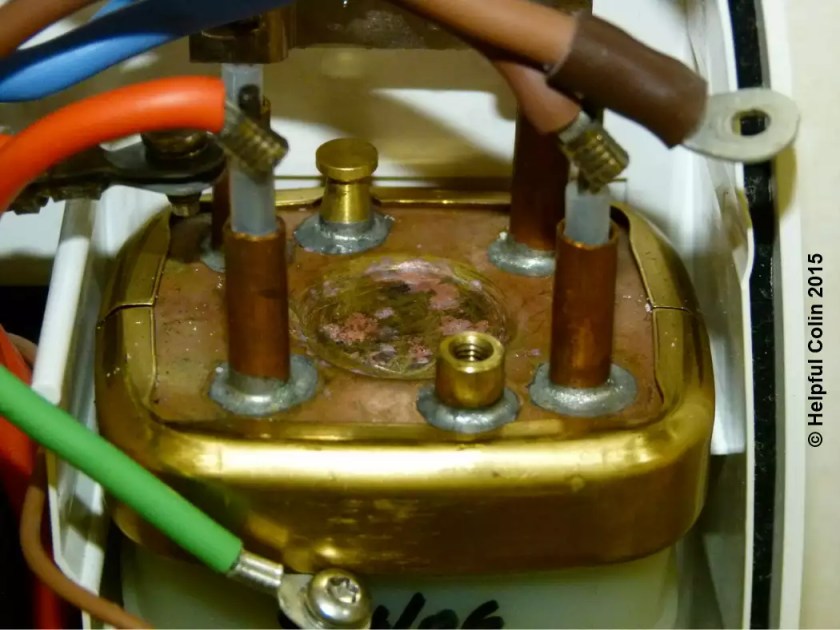
Putting A New Mira Shower Thermal Switch In Place
What happens to a faulty Mira Shower thermal switch on its way out is not a big issue, but getting a new Mira Shower thermal switch into place without damaging it is.
“It’s important to get a new thermal switch in place without damaging it.” – HC
WARNING

There are warnings on the Shower Doctors web site and on the packaging for the Mira Shower thermal switch. They warn that it will be ruined if the bimetallic disc is pressed in. So don’t be tempted to press it like a button.

This refers to the shiny silver-coloured printed disc on the underside of the Mira Shower thermal switch which you can see here. Not the orange label on the plastic topside.
So BE WARNED it is easy to accidentally press it in while manoeuvring it into place. It could get squeezed while struggling to get it through the rat’s nest of wires or pressed against the point of a heating element.
Below are four pictures of the Thermal Switch in consecutive positions while it is being placed in position atop the Heater Tank.

Pic.1. I Got the Thermal Switch into this position by threading it in from above the wires.
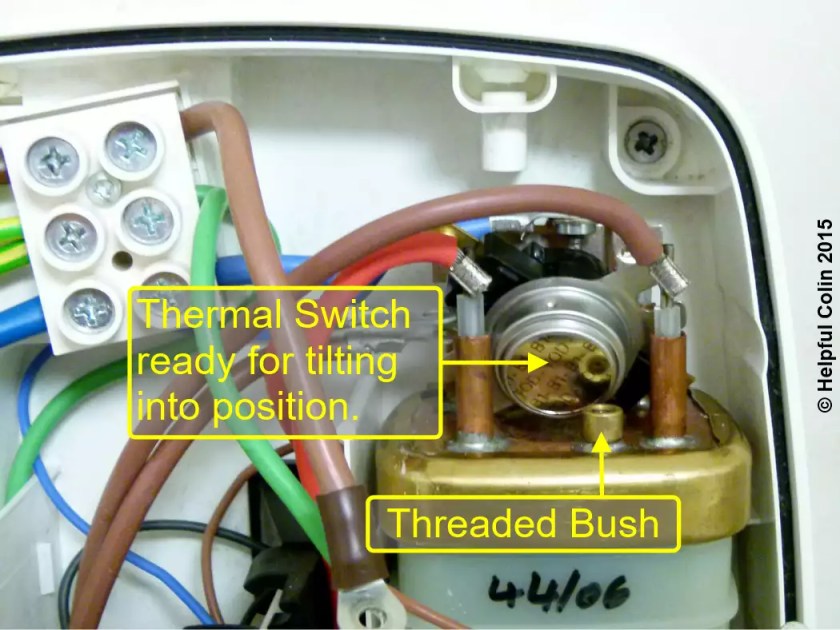
Pic.2. I Moved the Thermal Switch down between the wires to a position where it can be tilted over.
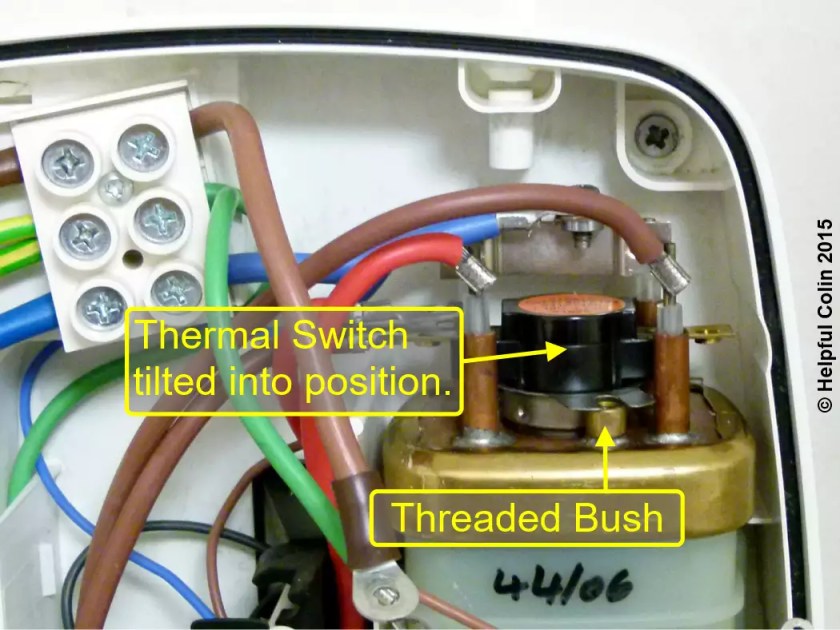
Pic.3. I Tilted the Thermal Switch over and put it under the stud at the back, then rested it on the threaded bush at the front.

Pic.4. Finally I screwed down the Thermal Switch and Earth wire, then reconnected all the other wires.
Replacing The Front Cover
After I had checked my work inside the shower I replaced the front cover.
Since I had been careful not to move any of the control knobs attached to the Front Cover or turn any of the controls in the shower I was able to align the cover with the case and press it into position.
While holding it and keeping it pressed into place with one hand I inserted the two top screws with my other hand, and then screwed them 90% of the way in. Then I inserted the bottom screw from a crouching position so I could look up and see where to put it and tightened it completely. I then tightened the top two screws completely.
Turning The Power On And Testing The Shower
With the shower rose hanging on the wall and the power and temperature settings normal I proceeded to reconnect the power by resetting the MCB and RCD and turning on the Shower Isolation switch. I observed the neon light illuminate on the isolation switch and behind the shower ON/OFF button.
Keeping away from the water jet I turned the shower on. It behaved normally with low initial output flow until the water warmed up. I tried various temperature settings and the appropriate temperature was maintained. There was no longer a sudden drop in temperature due to the Mira Shower Thermal Switch operating and cutting off the power.
At this point I considered the repair a success.
Further Issues
“In my opinion letting the thermal switch get wet is a design fault.” — HC
Since the initial repair I have had to replace the Mira Shower Thermal Switch several times. The last thermal switch lasted eleven months and now I have had to replace it again. This time it was very corroded. I am concerned about the amount of water that collects under the thermal switch. It rests in a hollow pressed into the copper top of the heater tank so the water cannot drain away. The hollow is probably made to ensure that the copper on which the thermal switch is mounted comes into direct contact with the heater tank water, else it might be in a pocket of air and be isolated from the heat of the water and so not operate correctly. In my opinion letting the thermal switch get wet is a design fault.
Replacing The Shower With A Better One
NOTE: I replaced this shower with a new ‘Mira Sport Max with Airboost’ shower on 17th July 2015 due to continued thermostat problems and a new tendency to continually cycle from hot to cold and back to hot.
Footnotes
- Beware of counterfeit and dangerous wiring regulations which cannot be trusted and have proven errors in them. The latest edition is available from the IET.
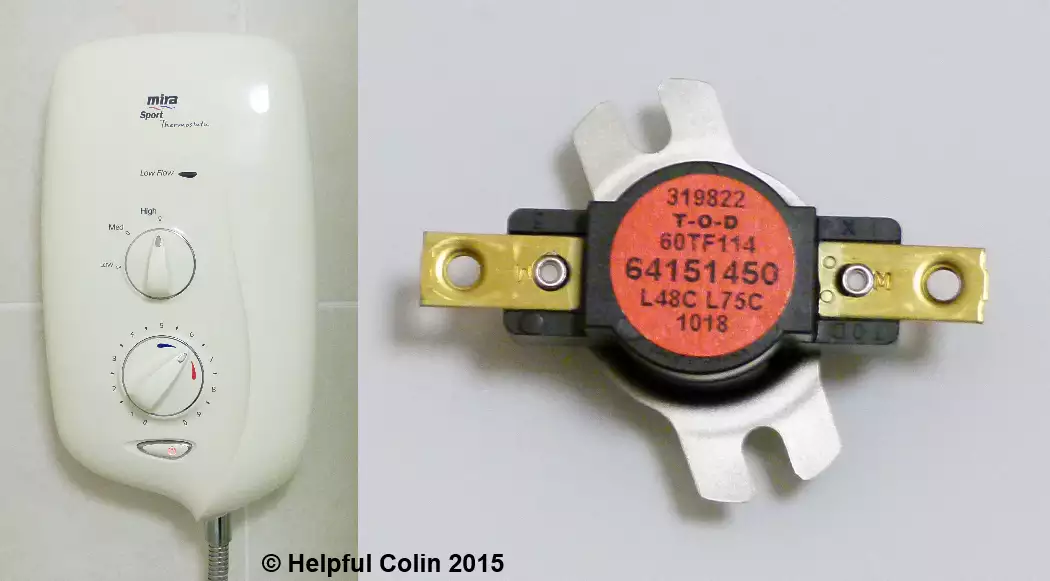

Leave a Reply